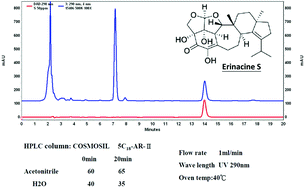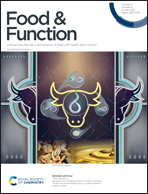Apoptotic mechanisms of gastric cancer cells induced by isolated erinacine S through epigenetic histone H3 methylation of FasL and TRAIL†
Abstract
Erinacine S, the new bioactive diterpenoid compound isolated from the ethanol extract of the mycelia of Hericium erinaceus, displays great health-promoting properties. However, the effects of erinacine S on inductive apoptosis in cancer cells such as gastric cancer and its molecular mechanisms remain unclear. Our results demonstrated that erinacine S treatment significantly induces cell apoptosis with increased ROS production in gastric cancer cells, but not in normal cells. Significantly, erinacine S also showed its inhibitory effects on tumor growth in an in vivo xenograft mouse model. Furthermore, immunohistochemical analyses revealed that erinacine S treatment significantly increases the FasL and TRAIL protein, whereas it decreases the levels of PCNA and cyclin D1 in the gastric cancer xenograft mice. Consistently, in AGS cells, erinacine S treatment not only triggers the activation of extrinsic apoptosis pathways (TRAIL, Fas-L and caspase-8, -9, -3), but it also suppresses the expression of the anti-apoptotic molecules Bcl-2 and Bcl-XL in a time-dependent manner. In addition, erinacine S also causes cell cycle G1 arrest by the inactivation of CDKs/cyclins. Moreover, our data revealed that activation of the ROS-derived and AKT/FAK/PAK1 pathways is involved in the erinacine S-mediated transcriptional activation of Fas-L and TRAIL through H3K4 trimethylation on their promoters. Together, this study sheds light on the anticancer effects of erinacine S on gastric cancer and its molecular mechanism in vitro and in vivo.



 Please wait while we load your content...
Please wait while we load your content...